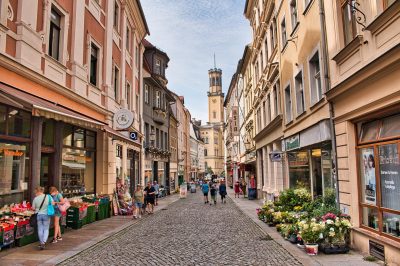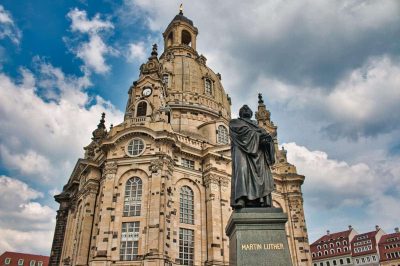There is plenty of sights to see in Görlitz Germany. The easternmost city in Germany is full of unique sights from all eras. Friends of medieval times get their money’s worth as well as admirers of the baroque period. But the greatest treasure of Görlitz are the countless Art Nouveau buildings. In total, Görlitz counts 4,000 listed buildings in the city. This is one of the highest numbers in all of Germany. Since Görlitz suffered little destruction during the war, it is one of the most beautiful cities in all of eastern Germany. Hollywood has already taken advantage of this in numerous films and new films are constantly being shot in “Görliwood”.
Görlitz Germany – What you must have seen
Görlitz has many places of interest. The list of places that we think you must see is therefore very extensive.
Görlitz Old Town
Görlitz has one of the best preserved old towns in Germany. Therefore, around the Obermarkt in the old town of Görlitz plenty of sights gather. Especially beautiful are the Untermarkt (Lower Market Square), the Fischmarkt (Fish Market), the Langenstraße, the Brüderstraße and the Neißstraße.

City hall with city hall tower
The city hall is one of the most prominent buildings on the Untermarkt. The Renaissance building still serves as the seat of several offices of the city administration. However, the most beautiful is the town hall tower. You can get to it via the town hall staircase, which is a very photogenic work of the early Renaissance. The two clocks are also worth seeing. During a guided tour of the town hall tower you will learn interesting historical details, for example about timekeeping in the Middle Ages.
The guided tours are the only way to get to the top of the city hall tower. For 4 euros you can enjoy the view with the Untermarkt is at your feet. We think this is the best view of Görlitz (more about this below).
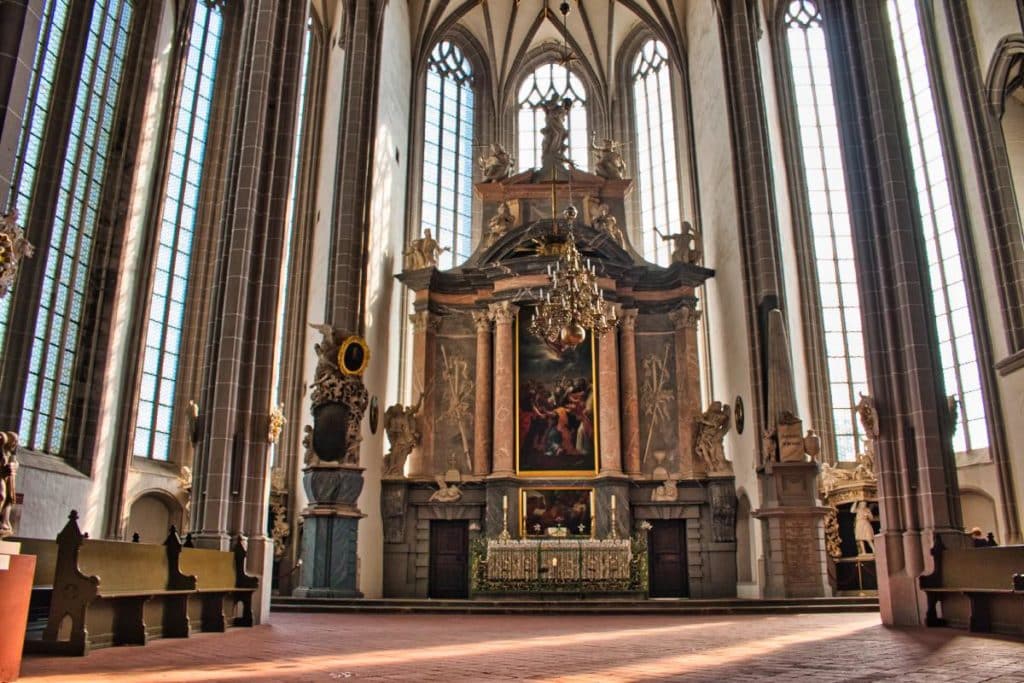
St. Peter’s Church
For many, the Gothic St. Peter’s Church is the city’s landmark. It is particularly visible from the Polish side of the Neisse River and dominates the cityscape. The copper roof of this large hall church is very striking in combination with the sandblasted light towers. The church holds 2500 people and is accordingly large. Organ concerts are held regularly in the church. The Sun Organ is one of the most beautiful and sonorous organs in Saxony. It is richly decorated for a Protestant church. You can also climb the tower.
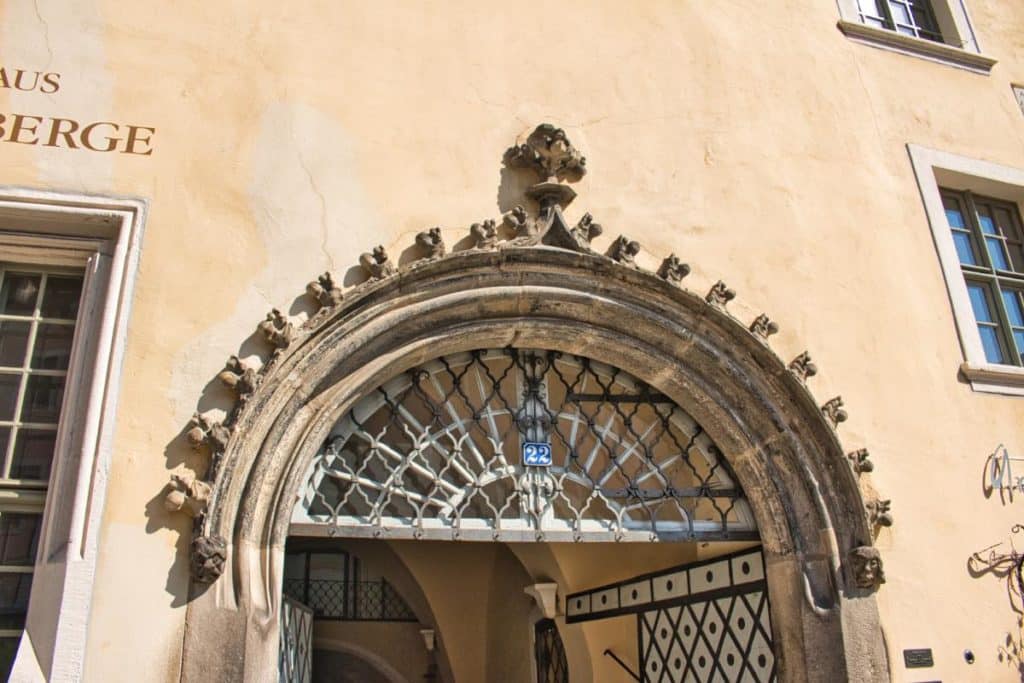
Whisper Arc
The portal at Untermarkt 22 is one of the most curious sights in Germany. Due to the peculiar construction of the late Gothic portal, sound is transmitted from one side of the arch to the other. So if you stand close to the arch with someone else on either side of the portal and talk, you can easily hear each other. It will sound as if the other person is talking through a can. However, you can both hear each other very clearly, even if you are only whispering. Others standing around, on the other hand, will not hear your secrets.
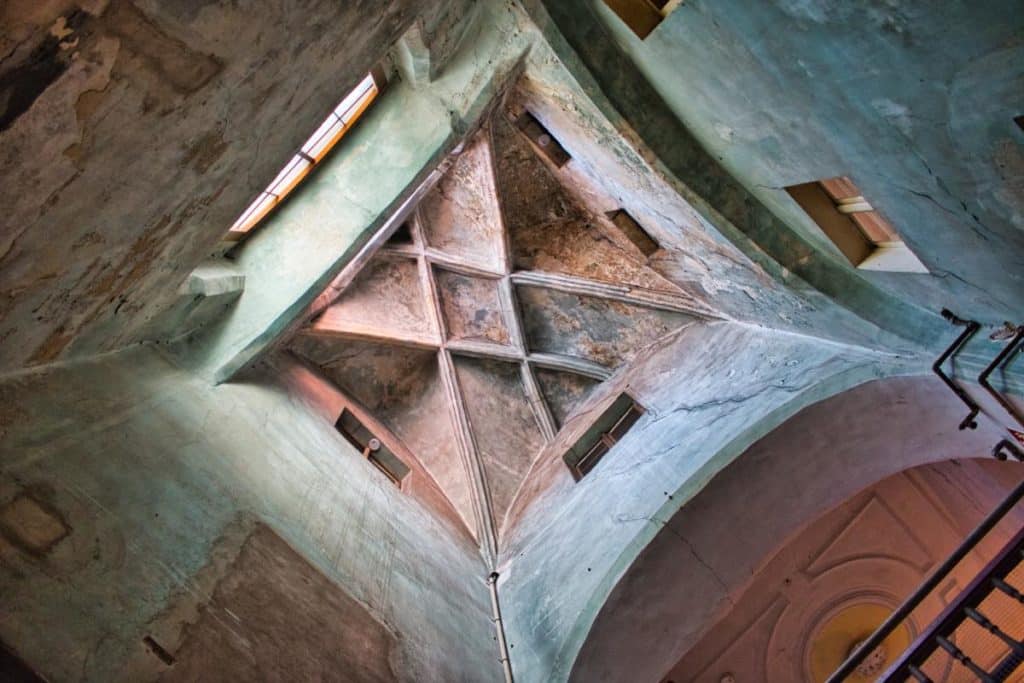
Görlitz hall houses
The hall houses are one of the sights of Görlitz that you won’t see right away. They are inconspicuous from the outside, but inside they resemble small palaces. There, real halls serve as corridors. Stairs go off in all directions. Windows are built in the direction of the halls and apartments are built in everywhere. You can explore one of the halls at Brüderstraße 9. There you can see an exhibition with an information film about the restoration of the houses.
There is also still a bathtub halfway up the stairs here and beautiful tiled stoves to discover. Admission is free, but donations are requested. Other well-known hall houses are, for example, the Biblical House and the Silesian Museum.

Upper Lusatian Library of Sciences
Even though the Upper Lusatian Library of Sciences is actually a part of the Museum Barockhaus Neißstraße 30, we must mention it separately here. Because the library, which was created at the end of the 18th century by educated citizens and noblemen as a library for their studies, is one of the most beautiful in the world. Here you can find some beautiful and old incunabula. But especially magnificent are the atlases, one of which was open for viewing during our visit. The library also provides one of the best photo spots in the city.

Holy Sepulchre
The Holy Sepulchre in Görlitz is a miniature copy of the Church of the Holy Sepulchre in Jerusalem. Although there are several other copies of the Holy Sepulchre in Germany, this one is by far the best replica. According to legend, Georg Emmerich, who later became mayor of Görlitz, impregnated a neighbor’s daughter and then refused to marry her. As penance, he went on a pilgrimage to Jerusalem, where he visited the Holy Sepulchre. Afterwards he returned to Görlitz and donated the copy of the Holy Sepulchre. However, this legend has since been disproved. However, Emmerich did indeed travel to Jerusalem and had an influence on the construction of the Holy Sepulchre. In Görlitz there is also a Way of the Cross, where every year on Good Friday a procession commemorates the sufferings of Jesus.
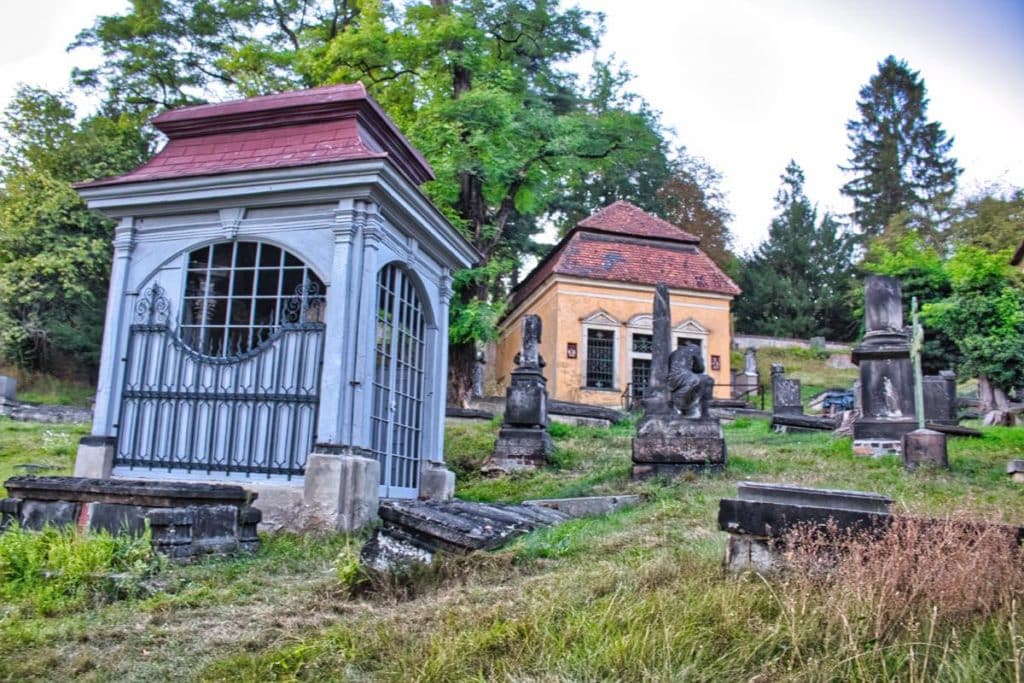
St. Nicholas Church and Old Nicholas Cemetery
The old Nikolai quarter in Görlitz offers a surprising sight. The Nikolai Church is one of the oldest churches in the city and the neighboring Nikolai Cemetery is attested as early as 1305. Most of the graves still visible today date back to the 18th century. Some of the city’s most famous citizens are buried here, including the mystic and philosopher Jakob Böhme. The view of Görlitz from the upper graves is especially beautiful in the evening. The cemetery is very quiet and you can relax here after an extensive exploration of the sights of Görlitz.

Art Nouveau in Görlitz
Art Nouveau is one of the most beautiful architectural epochs and is characterized by the varied and playful use of glass and steel. In Görlitz there is a whole quarter with houses from the Art Nouveau period. But there are Art Nouveau buildings in all parts of the city. The most beautiful examples are:
- Görlitz warehouse
- Görlitz synagogue
- Straßburg Passage
- Joliot-Curie-Straße 4–5
- Hotel Am Goldenen Strauss
The Art Nouveau district of the city center can be found starting from the Obermarkt behind the department store. Many Art Nouveau buildings can be found there.
Waidhaus
The Waidhaus is the oldest secular building in Görlitz. It dates back to the 12th century and has been used in very different ways in its long history – including as a brewery, school building and by the fire department. You have a particularly beautiful view of the building from the other side of the Neisse River.
Post Square and “Muschelminna”
The Post Square with the buildings from the imperial era is one of the most beautiful squares in the city. Both the building of today’s post office and the district court opposite make the square an eye-catcher. The biggest eye-catcher, however, is the so-called Muschelminna. The fountain figure got this name because of its shell-like shape.

Sights in Zgorzelec
Often forgotten in travelogues is the Polish part of the city of Görlitz. Once upon a time, today’s European City of Görlitz/Zgorzelec was a single city and Zgorzelec simply comprised the parts of the city located east of the Neisse River. Today, the German-Polish border is located here. However, due to the eastward expansion of the EU, this has already become less noticeable. A trip to Poland is therefore possible without any problems and definitely recommended.
Bridges
To get to Poland, you almost inevitably have to cross one of the bridges over the Neisse River. The most popular of them is the pedestrian bridge in the Old Town. It was blown up by German troops during the retreat across the Neisse River in World War II and was rebuilt and reopened in 2004. Next to the bridge on the Polish side stands the Dreiradenmühle mill, a popular photo motif.
Also very photogenic is the Neisse Viaduct, which provides a rail link from Germany to Poland. The city bridge next to the Görlitz City Hall is also a good place to cross the Neisse River on foot. From here you can quickly get to the House of Culture in Zgolzelec.
Upper Lusatian Memorial Hall / House of Culture Zgorzelec
The former Upper Lusatian Memorial Hall was once erected as a hall of fame in honor of the two emperors Wilhelm I and Frederick III, who died in the Year of the Three Emperors, 1888. Externally modeled on the Reichstag in Berlin, the building was erected in 1902 in the presence of Emperor Wilhelm II. After the defeat in World War II, the parts of Görlitz east of the Neisse River fell to Poland.
The Polish communists converted the building into a house of culture. Most signs of the emperor’s presence disappeared. Today, the Memorial Hall is the landmark of Zgorzelec and is currently undergoing extensive renovation. In recent years, meetings of the joint city council of Germans and Poles have often been held here.
Jakob Böhme House Zgorzelec
Jakob Böhme was actually a cobbler, but he also wrote philosophical works in the 16th and 17th centuries. Hegel therefore called him the first German philosopher. Böhme grasped opposites as a unity, since according to him, without evil, good would not exist. His views earned him the wrath of Lutheran priests and he was antagonized for his ideas. Boehme lived in Görlitz. His house still stands on the Neisse River, but today it is not far from the Old Town Bridge on the Polish side. In the museum you can learn about the cobbler-philosopher and life at that time.
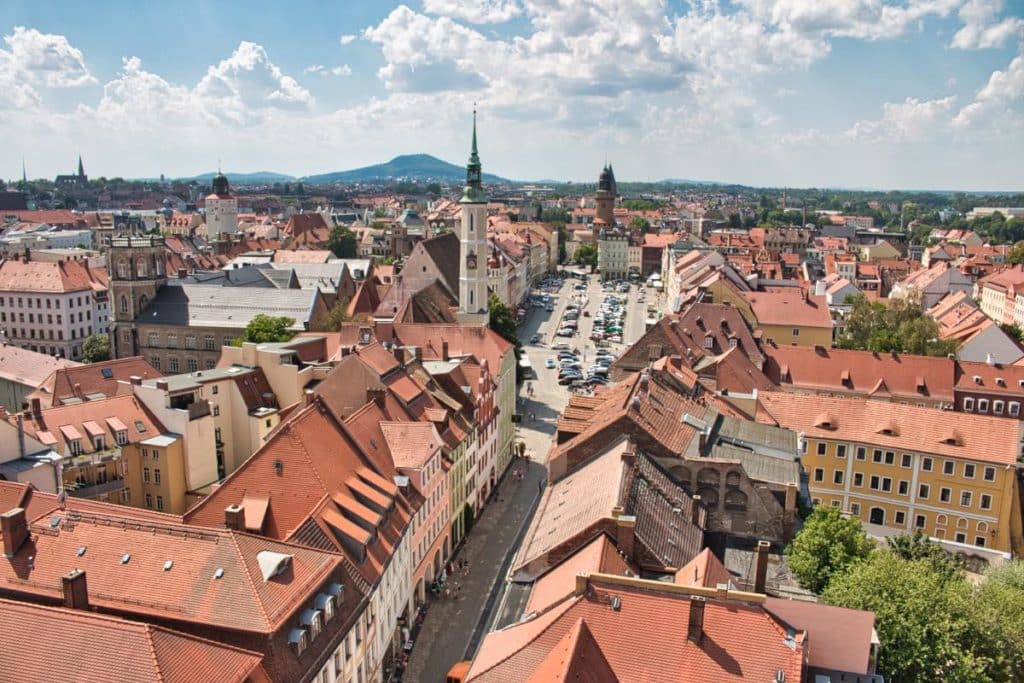
Görlitz – Best view
Görlitz is not exactly a flat city. In addition to the hills, there are all kinds of towers. But there is a good view of Görlitz in many places.
Towers
In Görlitz, there are a number of towers that can be climbed and from which the city can be seen from different angles. The guided tours to most of the towers are led by volunteers of the Förderverein Kulturstadt Görlitz-Zgorzelec.
- Town hall tower – the best view in the city, located directly on the market square, great overview of the sea of alleyways and view of the crown of the country and as far as Liberec to Jested, in good weather even as far as the Snowcap, also the only view without a window
- Dicker Turm – at 46 meters, not the tallest tower, but “the fat one” offers a view of the town hall tower, St. Peter’s Church and Holy Trinity Church
The other towers are also interesting and offer beautiful views.
- Reichenbach Tower – at 51 meters, the highest surviving tower of the city wall
- Tower of St. Peter’s Church – the two highest towers in the city can be climbed at St. Peter’s Church and offer a fantastic view over the Neisse and, on a clear day, as far as the Giant Mountains
Landeskrone
The Landeskrone is not only the local mountain of Görlitz. This extinct volcano is also a must to enjoy the view over the whole region during a climb. Because from this elevation you can look further than from any other place. You can also enjoy a beautiful view of Berzdorfer See from up here. Unfortunately, the view has its price. You have to climb the 420 meter high mountain on foot. The climb takes between 30 and 45 minutes, depending on your physical condition. For people with disabilities, the climb is hardly possible, the path to the top is not barrier-free.
Neiße Bank
Even though the bank of the Neiße River is one of the lowest points in the city, from the Polish side on the bank of the Neiße River in the Old Town you will have a fantastic view of the Old Town of Görlitz, especially in the morning, and you can take some of the best photos of the city.
Museums in Görlitz
Görlitz is not only a historical city, there are also a good dozen museums dedicated to different topics.
Schlesisches Museum
The Schlesisches Museum (Silesian Museum) presents the history of the cultural region of Silesia. It also covers the parts of the country that no longer belong to Germany, such as Wrocław and Jelenia Góra. The museum is supported, among others, by the Silesian Landsmannschaft, the descendants of the expellees from Silesia. The special exhibitions often attract attention even outside the region.
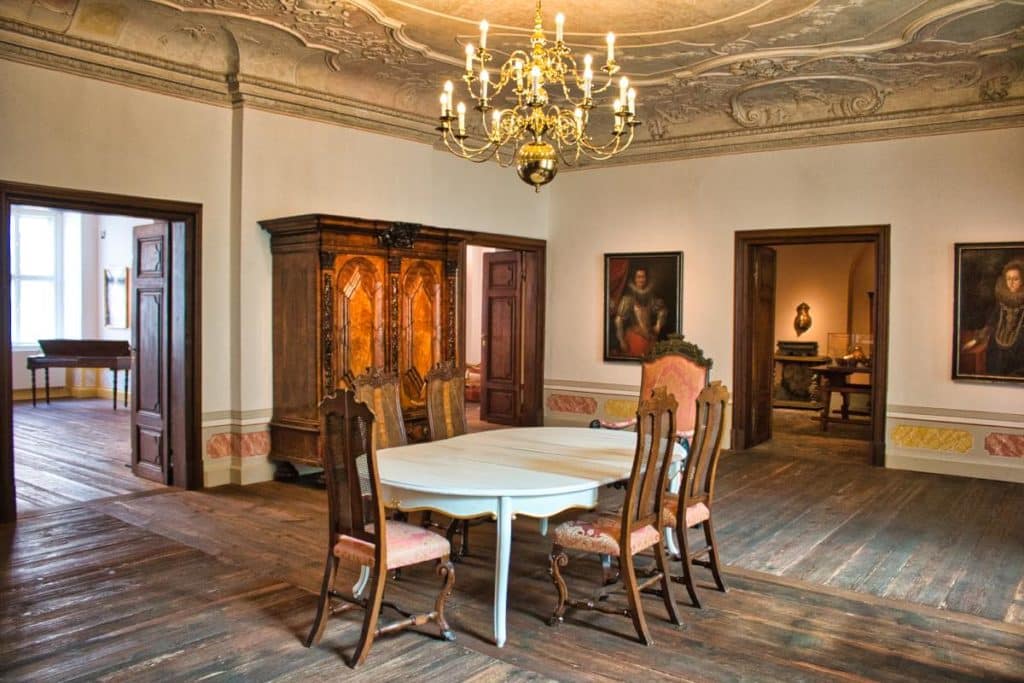
Barockhaus Neißstraße 30
Seing how people lived in the Baroque period – this is possible at Barockhaus Neißstraße 30. The house was built for the rich canvas and damask trader Christian Ameiß. To this day, it shows in a unique way how people lived in the early 18th century in Görlitz. The exhibition also includes the Upper Lusatian Library of Sciences, which was maintained here by intellectual citizens and noblemen. The Baroque house is a must-see when visiting Görlitz.
Other museums in Görlitz
- Kaisertrutz – Museum on the cultural-historical development of the city and region, Gallery of Modern Art on the upper floor
- Toy Museum – Exhibition of toys from several centuries
- Senckenberg Museum of Natural Science Görlitz – Museum presentation of nature with aquarium and stuffed exhibits and specimens on natural history
Movie city Görlitz
Due to the excellently preserved architectural monuments from all eras, Görlitz is repeatedly used by film studios to recreate a historical city. It so happens that not only German, but also international Hollywood productions were made here. Among the films that were at least partially shot in Görlitz are:
- Grand Hotel Budapest
- Inglorious Basterds
- Der Vorleser
- In 80 Days Around the World
- The Tower
- Wolfland
Many of the film locations are open to the public and can be explored on a walk. You can find an overview of all known films and the respective film locations in this overview.

Görlitz Department store
The most famous film set in Görlitz is the Görlitz department store (Görlitzer Kaufhaus). Among other things, it served as a backdrop in the film Grand Budapest Hotel by Wes Anderson. The Art Nouveau building from 1912/1913 is actually one of the most beautiful and interesting buildings in the city and should definitely be visited. The current times for the visit are posted in the windows of the department store (during our visit in August 2020 it was on Thursdays and Fridays from 1 to 6 pm).
Görliwood Entdecker
Since 2020, there is a red double-decker bus that drives to all important film locations in Görlitz Germany. In one hour, you can see the most important locations, hear stories from a city guide, and get off the bus briefly at some of the stops. The red double-decker buses are open at the top. Photo freaks and fair weather friends sit therefore above best, because so no window glass is in the way. Meeting point is at Obermarkt, the bus runs several times a day.
Walk of Görliwood
Also since 2020, the city has established the Walk of Görliwood. Here, information about and images from the films shot in Görlitz are shown at various stations. The panels are illuminated and can thus be admired even in the evening.

Jewish Görlitz
Jewish life existed in Görlitz as early as the 13th century. In the medieval old town there was a Jewish quarter, called Judengasse, with a synagogue and a mikvah, a Jewish bathhouse. However, the people of Görlitz expelled the Jews from the city in 1389. Settlement was only permitted again by the Prussian government in the mid-19th century.
The Jews of Görlitz were considered to be not very religious, so that not even enough Jews always came together to hold services. The Jews of Görlitz were often active in trade, but therefore also suffered from the world economic crisis. During the Third Reich, the targeted persecution of Jewish Germans also began in Görlitz. The Jews emigrated and were later deported to the labor and extermination camps.
Görlitz Synagogue
The present synagogue was opened in 1911, after all other synagogue buildings in the city had become too small. The community raised money for a long time until they were able to build this impressive structure. The synagogue is one of the most beautiful Art Nouveau buildings in Görlitz. During the Reichspogromnacht in 1938, Nazi henchmen attempted to set fire to the building. Most of the interior furnishings were destroyed, but the building remained standing. After the expulsion and deportation of the city’s Jews, the house of worship fell into disrepair during GDR times.
It was only after the fall of the Wall that it was gradually renovated. The synagogue, which is now almost finished, is scheduled to open in 2021 at the latest. Then you can visit this only remaining Jewish sacred building in Saxony again.
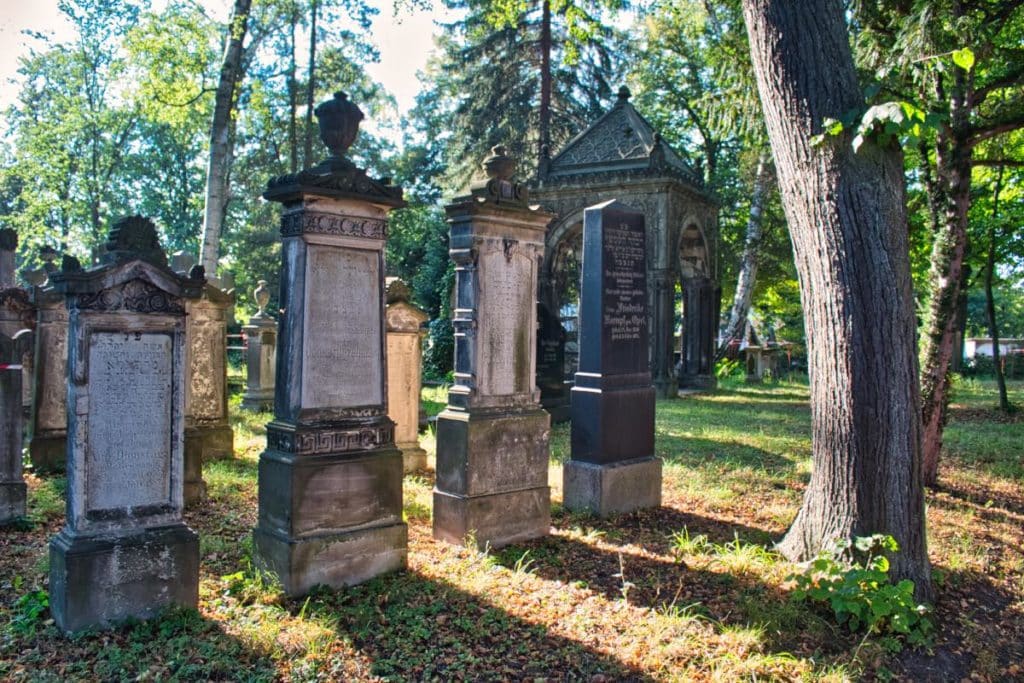
Jewish cemetery Görlitz
The Jewish cemetery was rededicated in the middle of the 19th century when the Jewish community of Görlitz was reestablished and has been largely preserved despite the Third Reich. Many Jewish citizens of the city from the time before 1933 are buried here. But memorials have also been erected to many Görlitz residents murdered in the Holocaust and to prisoners from the local concentration camp. Thus, the ashes of more than 300 prisoners murdered by the Nazis were brought here.
The cemetery is openly accessible until the evening, when it is locked by the municipality. The cemetery often has a mystical appearance. There are also some explanations about the gravestones and Jewish burials. Men are asked to wear cover their heads in the cemetery.
Stumbling stones in Görlitz
In Görlitz Germany, too, stumbling stones commemorate the deported and murdered Jewish inhabitants of the city. The stones can be found, among others, in Jakobstraße, at Demianiplatz, at St. Peter’s Church at Vogtshof or at Postplatz. Here you can find a list of the so called Stolpersteine in Görlitz.
Görlitz Concentration Camp Subcamp at Biesnitzer Grund
A Görlitz satellite camp of the Groß-Rosen concentration camp also existed from 1944 onwards. It was located at the so-called Biesnitzer Grund not far from the Jewish cemetery. As early as 1939, the Waggonbaufabrik (WUMAG) had acquired the site from the city and had it developed as a forced labor camp. The Nazi authorities sent the workers here to exploit them for the campaigns of the German troops. In 1944, the labor camp was closed and placed under the control of the Groß-Rosen concentration camp near Breslau.
A total of around 1500 prisoners are said to have been deployed here. A memorial in the Jewish cemetery commemorates more than 300 prisoners who are known to have been murdered there. After the war, the camp was demolished. However, one barrack was dismantled and rebuilt next to the synagogue. Until a few years ago, their origin was not known. There are considerations to designate it as a memorial.
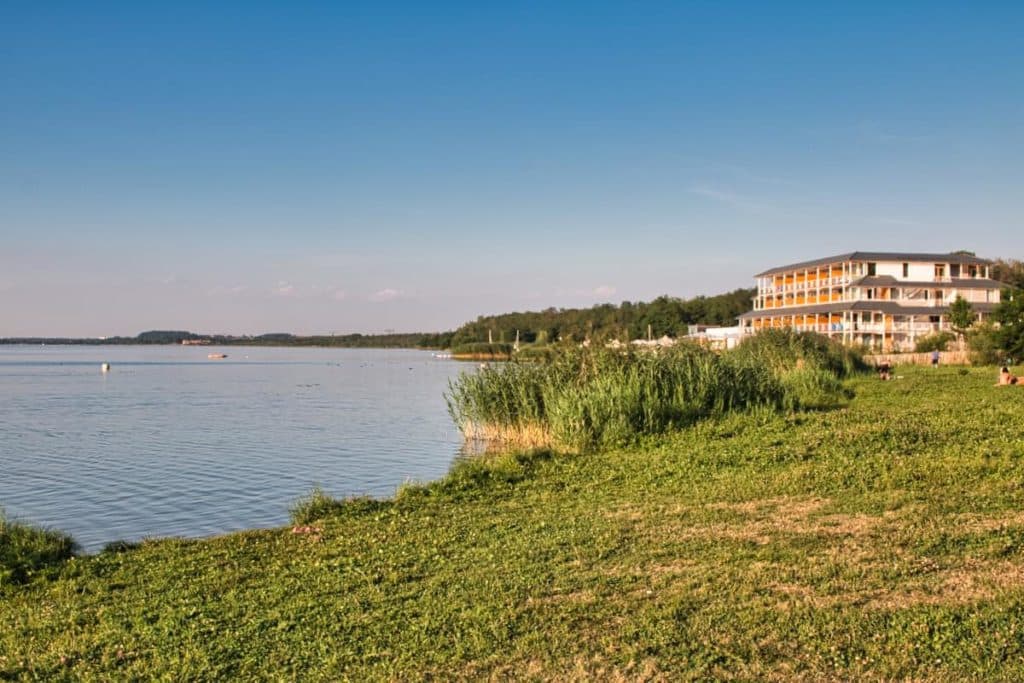
Trips from Görlitz
Lake Berzdorf
The Berzdorfer See (Lake Berzdorf) is something like the bathtub of Görlitz. The beaches are often crowded by the whole city in summer. The lake is a flooded open pit mine and the easternmost point of the Lusatian Lake District created from open pits. Here you can also go sailing or do other water sports. A cool sight is also the bucket wheel excavator 1452, which stands at the lake and can be entered as a walk-in museum.
Königshain Mountains
The Könighainrt Berge (Königshain Mountains) are a protected landscape area west of Görlitz. Here, thanks to the forests, there is not only fresh air, but also steep cliffs, rock towers and rock formations that you can explore during a hike.
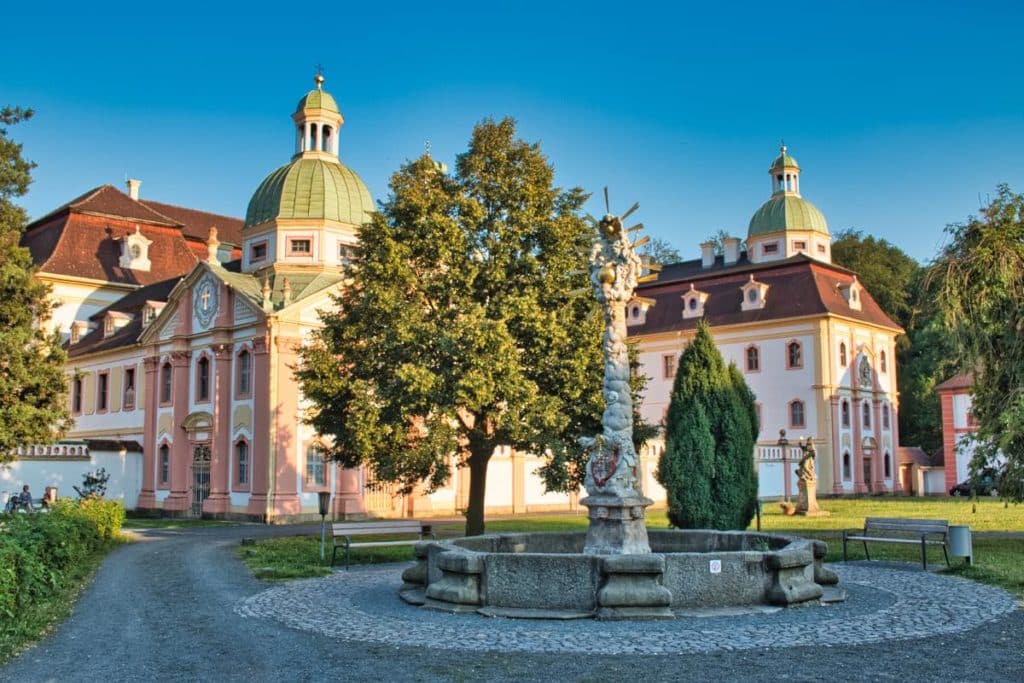
Marienthal Monastery
Marienthal Monastery is a gem on the road between Görlitz and Zittau. The Cistercian abbey is located right next to the Neiße River, which is why it has often been affected by floods. The grounds house a cozy guesthouse, there is a brewery, a farm store and a mill. It is possible to eat in the dining room. In the garden of biblical plants there are many plants mentioned in the Bible.
Eating and drinking in Görlitz
As the easternmost city in Germany, Görlitz is not only geographically close to Poland. Many culinary influences also meet here: Silesian, Saxon, Polish, Bohemian and other influences enrich the cultural experience and increase well-being.
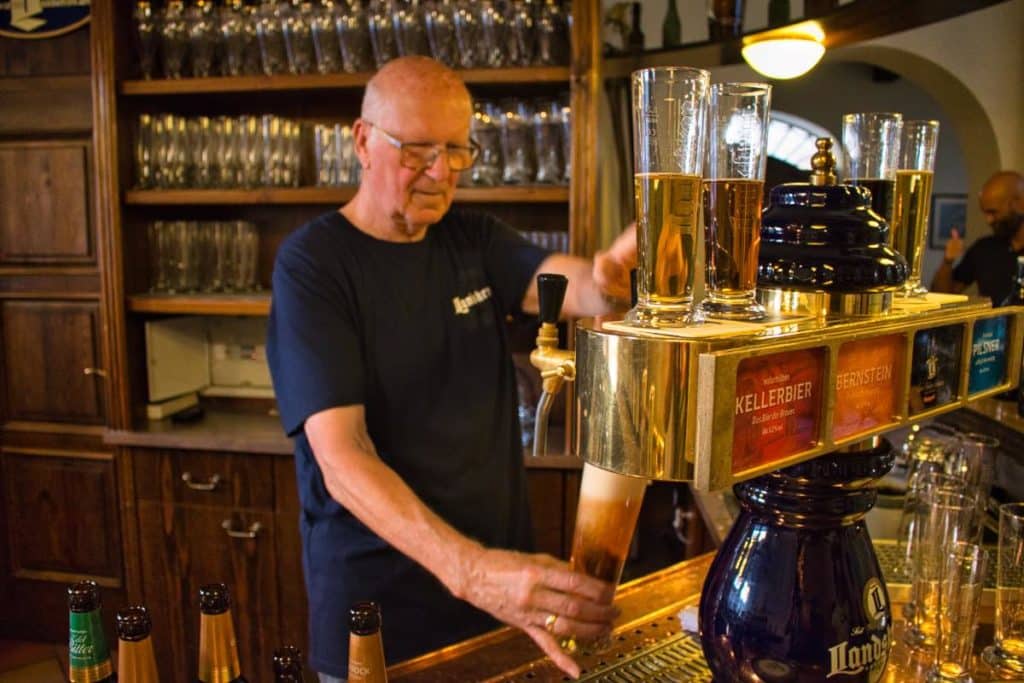
Landskron Brewery
Landskron has had a long odyssey. The brewery was bought and sold by several large breweries. It didn’t really fare that well. In 2006, it was sold to the Lohbeck family, which also owns several hotels. Since then, Landskron has been doing better and better. In 2019, the former engine house was opened as a modern visitor center with store and bar. All beers in stock are served at the bar. Brewery tours also start from here, where guests can not only look behind the scenes, but also get some beers and a Landskron mug for free. For currently 10 euros admission, a real bargain.
Bürgerstübl
Bürgerstübl is a rustic restaurant located directly in the old town in one of the medieval houses with a nice ambience and friendly waiters. If you want to try Silesian Himmelreich, a local speciality, this is the place for you.
Lucie Schulte
The food at Lucie Schulte is very tasty and innovative. The team goes all out with presentation and some annual gastro events and stylish dinners.
Restauracja Miód Maliny
In a European city on the Polish border, it is naturally advisable to also make a culinary detour to Poland. Restauracja Miód Maliny in Zgorzelec is the right place for that. Polish and other European dishes are tastily prepared here. The restaurant will be renovated in 2020, so we recommend checking the Facebook page to see if it’s already open again.
Café Lucullus
For real Silesian desserts, go to Lucullus. The cakes are the best in town. The Silesian poppy seed cake (also called Mohnpiele) is stunningly good. Many thanks for the recommendation to Meike from the blog Meikemeilen (greetings to Wuppertal). On the cozy terrace it is even better to feast.
No products found.
No products found.
No products found.


